Two days ago, while I was photographing Forster’s Terns in flight at Bear River MBR, I noticed what I thought might be a Black-necked Stilt nesting nearby. But it was so obstructed by emergent vegetation in front of it I decided to ignore it, at least for the moment, and concentrate on photographing terns.
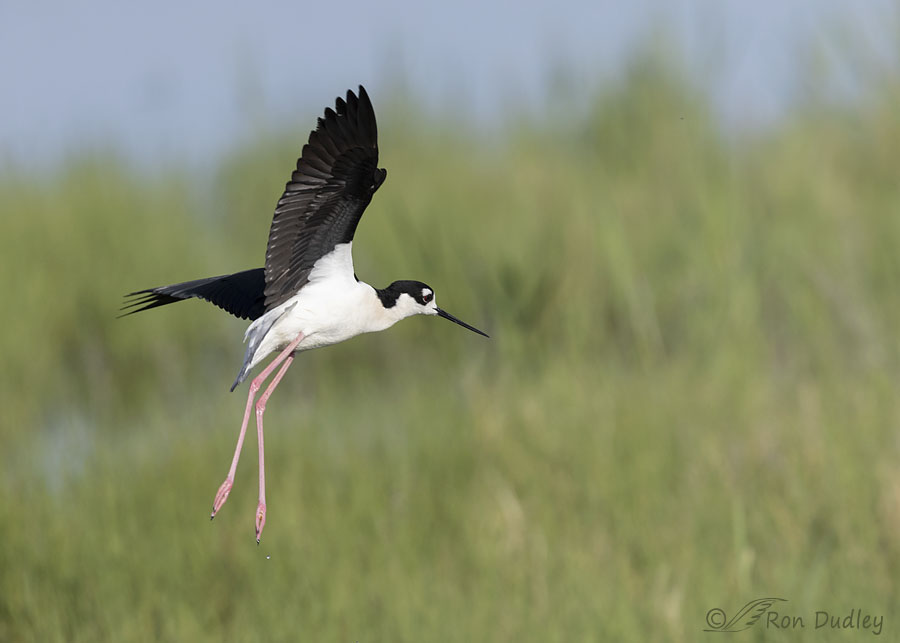
But a few minutes later this stilt (it turned out that this was the male of the mated pair) came flying in over my left shoulder and landed fairly close to the presumed nest and its occupant. So I moved my pickup a few feet so I could see the nest a little better and watched both stilts to see what might happen.
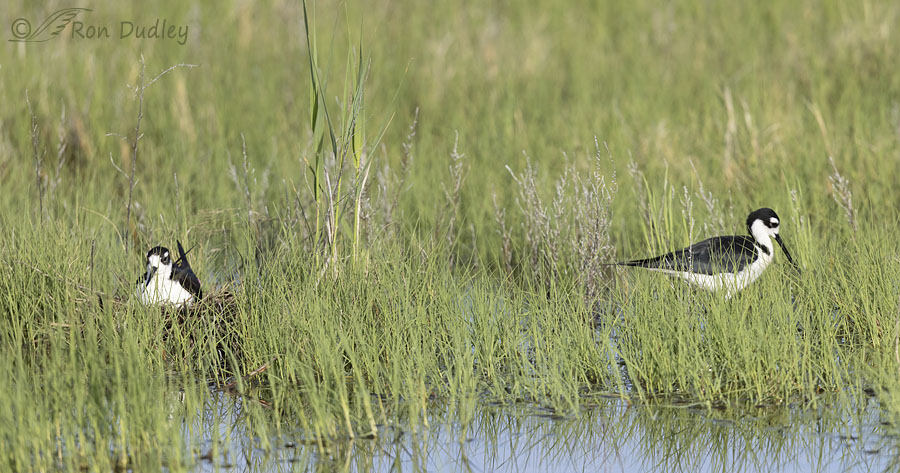
The male, on the right, had landed near the female on the nest but he seemed to be ignoring her so at first I wasn’t sure if they were a mated pair or not. When I spotted a couple of fishing terns approaching…
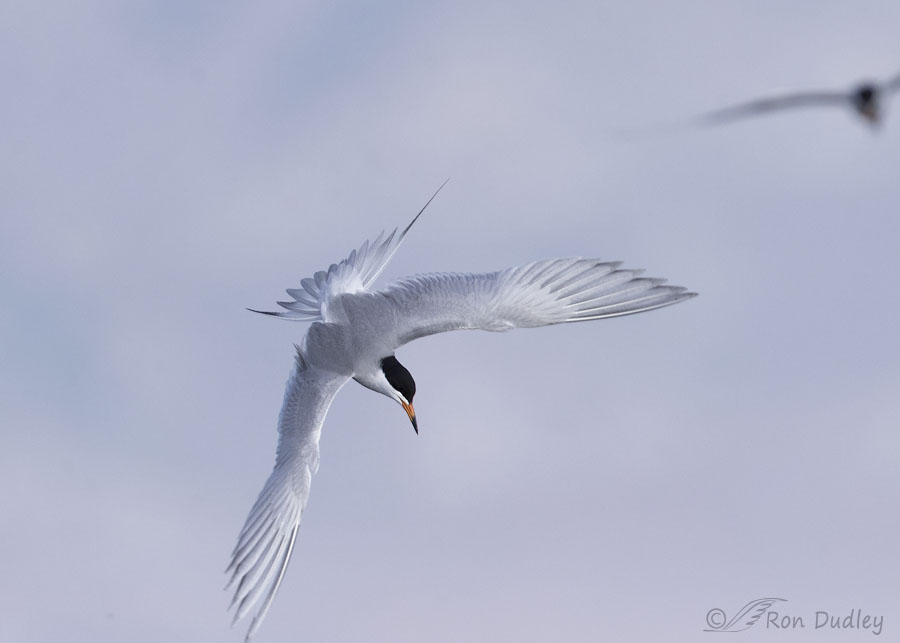
I turned my attention to them. Because I’d been watching the stilts, these two photos of a diving tern are grab shots, which I believe is what caused me to clip a wingtip.
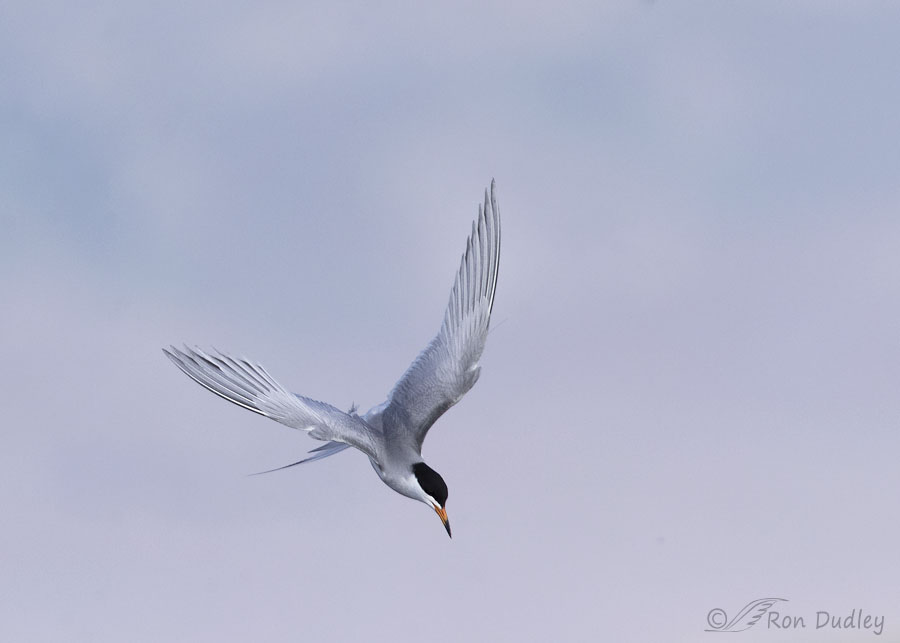
In the next shot in the burst I lost the photobombing tern in the background and I didn’t clip any body parts but I didn’t get a catch light in the eye in either shot.
When I glanced back at the stilts, “stuff” was happening.
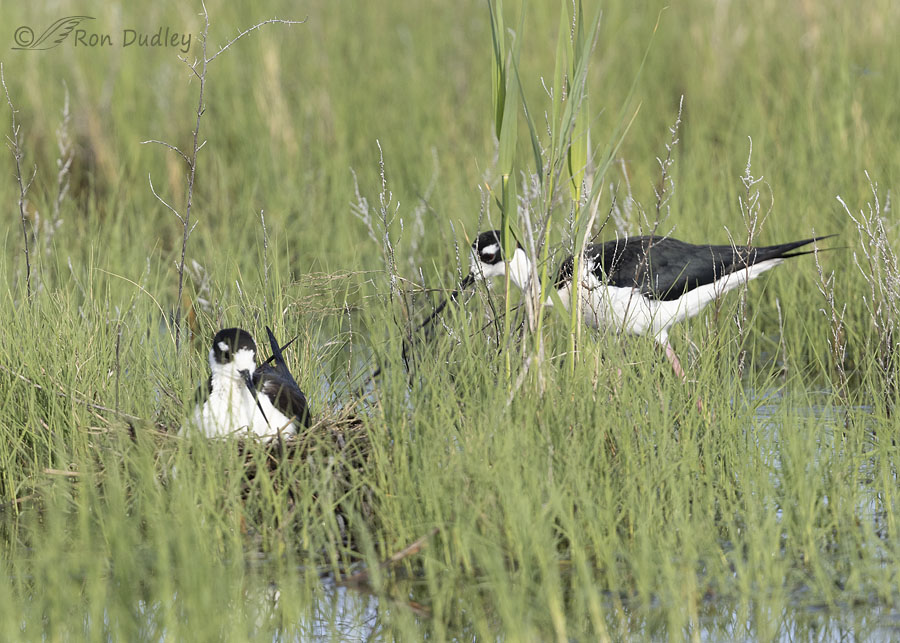
The male was slowly and very carefully approaching the female on the nest. He walked behind and around her…
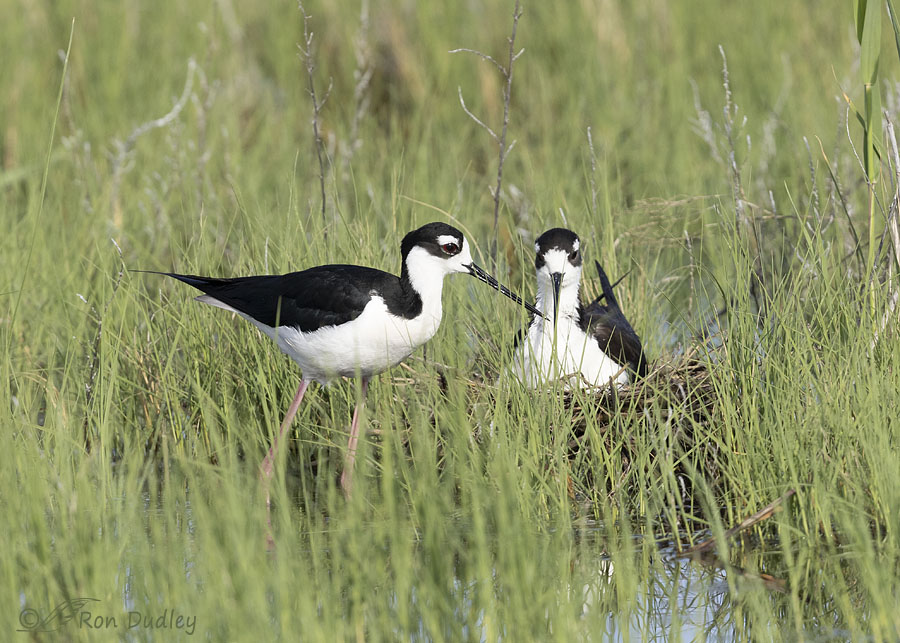
and approached her very closely.
At this point I documented a snippet of endearing stilt behavior that I’d never seen before. Or even heard of.
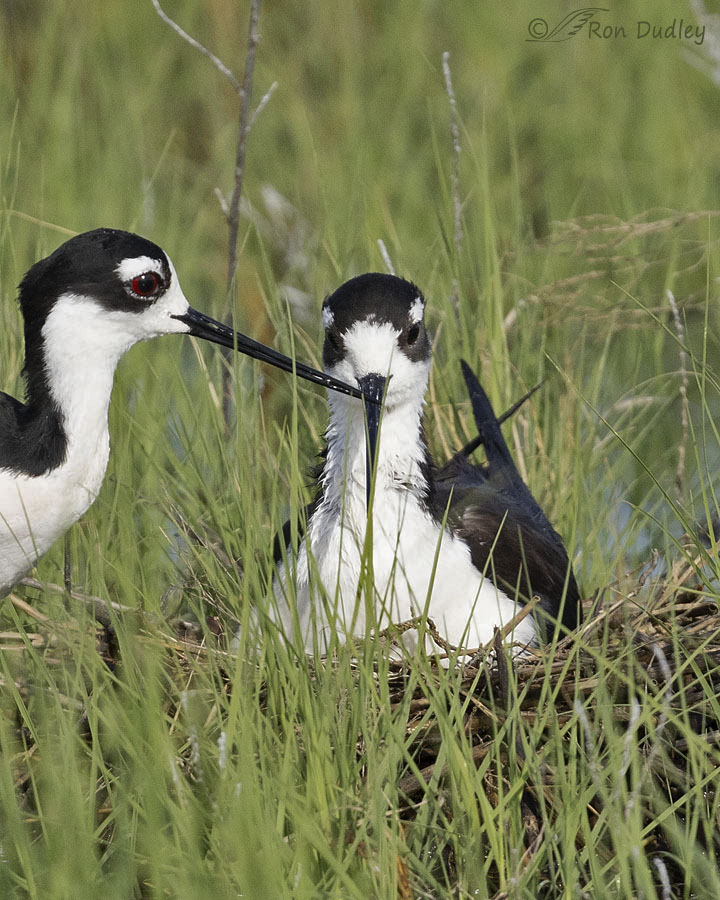
The male placed the tip of his bill beneath the base of her bill and appeared to lift up, which I interpret as his attempt to encourage her to leave the nest and allow him to replace her.
I tried to research this charming behavior with Cornell’s Birds of the World but they don’t mention it.
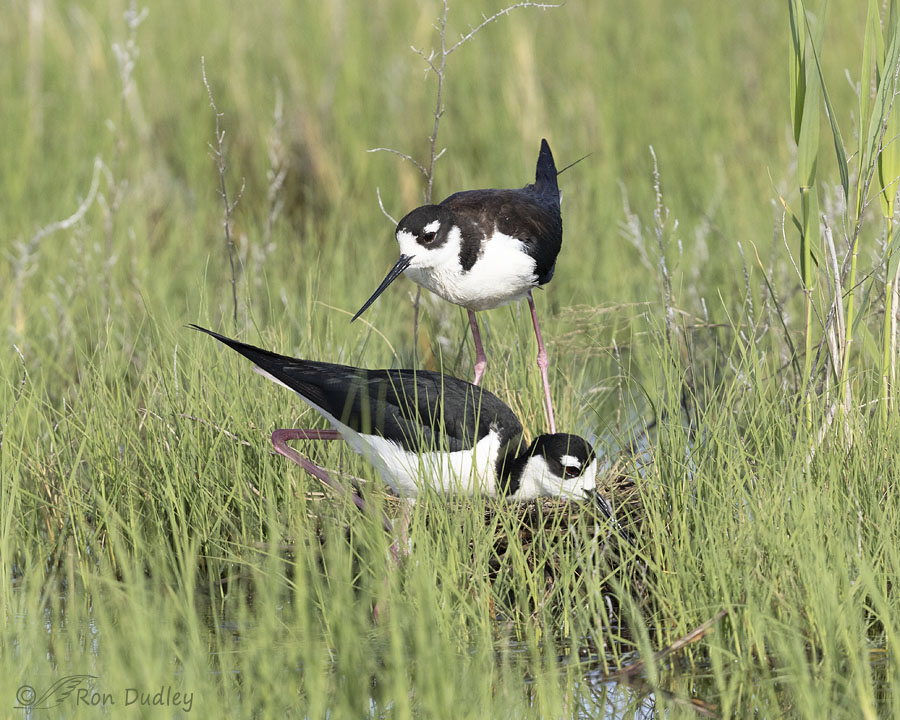
That was all the encouragement she needed to at least stand up.
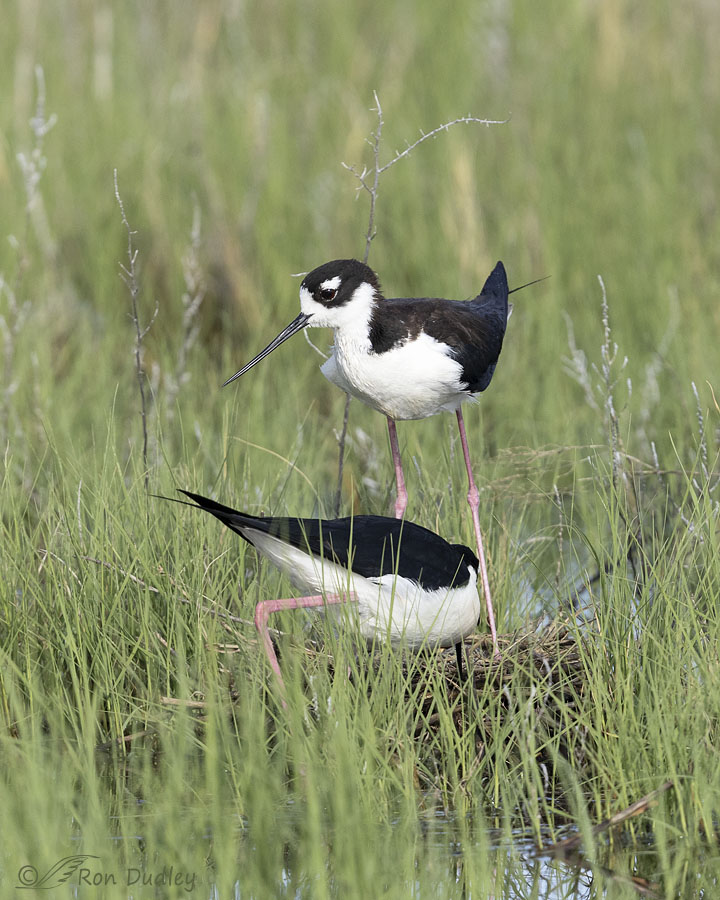
But she was reluctant to actually leave the nest, so he had to place his bill and head between her legs (in a later shot his bill is actually between them) before she stood up completely and…
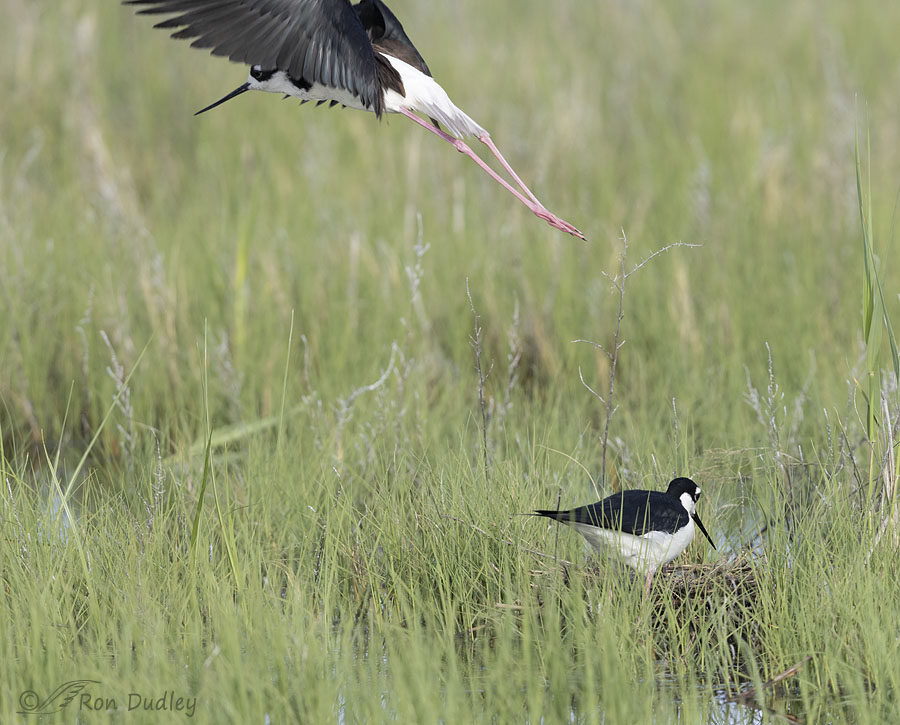
flew off.
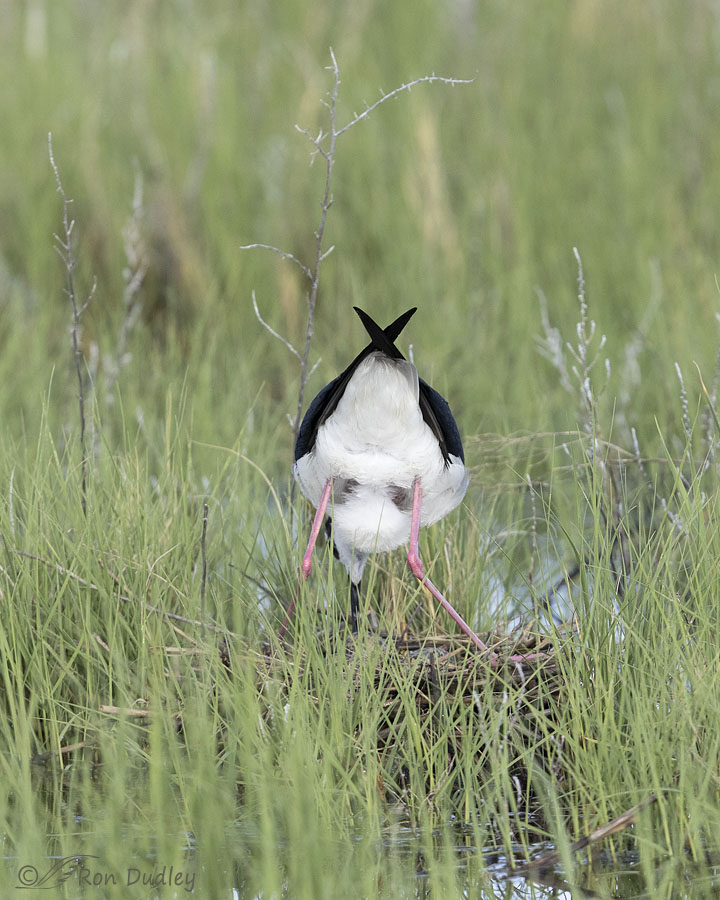
Then the male climbed up on the nest and…

settled in for his turn at incubating their eggs.
At this point, because he was obstructed by vegetation and he had his back to me, I went back to photographing terns. As I said in yesterday’s post, I don’t need any more butt shots. Even of nesting stilts.
Ron
Note:
In the “Excerpt” that went out to blog subscribers via email I referred to an “endearing tern behavior” rather than an “endearing stilt behavior”. Once again, coffee deprivation was my undoing. I’m working on it…


I dallied on commenting until I found a series of photos in my files. I witnessed the mating of a pair of Black-necked Stilts a while back, and the most amazing part of the whole thing was the bill-crossing that took place once the actual mating was completed. They spent some time snuggled up together with their bills crossed, and then proceed to stroll down the flats together, perfectly synchronized, for a few minutes. Eventually they separated, and went their own way. Your post, combined with my experience, suggests to me that this is a typical bonding behavior. It’s wonderful!
Wow – a very special sight to see! I don’t often comment and love all your posts. This was just so endearing somehow! Thanks for all your work, MM
Wow, Ron!! Your post is so special!! Black-necked Stilts were a new bird to me until we took a boardwalk tour at Green Cay Wetlands in 2014. They are so unique.
I commented earlier but for whatever reason it didn’t go through.
Best butt shots ever.
Thanks for documenting and sharing the “billing” behavior. Totally understand the Cornell thing. They are a valuable resource but apparently a bit snooty. or bureaucratic. Or both.
Lyle, maybe Cornell has their own self-imposed regs that require anything they put out for public consumption be sourced from “bonafide” professional researchers. But if so, you’d think they could respond and tell me so. How much effort would that take…
The Birds of North America project started at ANSP when I worked at VIREO. It subsequently moved to Cornell and was expanded to cover the world’s birds. Back then it was largely author driven for revisions and then goes through an editing process. I expect it still is, so new info gets in mostly through major revisions coming from the authors. There are many citations of otherwise unpublished information obtained through personal communications. Contacting the authors of the b n stilt account directly is probably the best way to get new info into a future revision.
So sweet! Like stroking a sleeping spouse to gently wake them up.
Thanks, Arwen.
Another series to send to Cornell! What a sweet daddy making sure mommy gets a rest! I wonder if some of these critters think to themselves, “The awesome Zoology teacher is here — we gotta do something cool for him!”
Thanks, Marty. It’s probably more like “That nosy biology teacher is here”.
Then they’d be talking about me.
I dunno. I’m the one with the big nose (lens)…
DEFINITELY endearing. And educational. Win/win.
Thanks, EC.
Ron this is awesome!!!! Revolutionary!!!!!
Beautifully captured and intimate shots of a very lovely ritual!!!
Have you considered sending Cornell a link to your blog? They should be so excited to see this!!!!!!!
Thanks very much, Lois.
I’ve sent Cornell photos and links to unusual or previously undocumented bird behaviors in the past and I’ve pretty much been ignored. So I no longer do it.
These are wonderful. So neat to observe the communication between the pair of stilts. Often science doesn’t acknowledge what would be considered emotions and communication in animals unless they can repeatedly document and recreate it in a controlled situation. Most people who work with and live with animals see it and don’t see much difference in animal and humans, just a different language.
Thanks, April. I know of few people who have had more experience up close and very personal with wild birds and critters than you.
Wonderful series! Loved seeing those sweet photos and learning “new” bird behaviors!
Thank you, Joanne.
Michael said it very well…….I really appreciate the glimpses that you provide
into these creatures’ lives that I would otherwise never see. The stilts are
SUCH HANDSOME BIRDS ! Without your closeups, I’d never have seen that their dark eyes are a beautiful garnet red, and I love
the behavioral observations that you provide every day–thanks !
Kris, at times it can be difficult to capture that red in their eyes, depending on the light. It’s something I always enjoy seeing when I’m successful.
Yes – it is imperative that we coffee consumers have gone through at least our first cup before doing anything such as sending an e-mail out into the world.
What an interesting documentary Ron. All you needed was to have David Attenborough narrate this story of the nesting Stilts. That lifting of her bill as a possible signal that he was ready to take over the nest is something you would never see without the close up photography. I have seen the Stilts many times here, but never any evidence of nesting. Thanks for a very educational post.
Attenborough is special, isn’t he Everett. Among many other things, I love his voice and the sense of wonderment it conveys so very well.
You’re special too, Ron Dudley. I love your photographs and photo essays.
I love this! A wonderful peek into a seldom-if-ever-seen personal interaction between these two creatures.
Thank you for sharing this; a thing that most of us may never see for ourselves. And I appreciate the backstory. It gives a glimpse into the person and the making of those things that only happens when one is passionate, persistent, observant, knowledgeable, intuitive, and just a bit lucky. This why I keep coming back to this blog. Well done Ron.
Thanks very much, Michael. I’m delighted that you “keep coming back”.
Good capture of the Stilt behavior – appears that even tho mom wants a break she’s reluctant to hand it over to the male! The 2nd “grab shot” of the tern is beautiful catch light or no! Stands out just enough from the complementing background – VBG!
Doing the Memorial Day weekend rain thing – we’ll take it as that may be the end up it! At least it’s not a foot of snow!
Thanks, Judy. Last night I spent some time looking at the 10 day forecast for southwest MT. Lots of cloudy skies and thunderstorms are forecast.